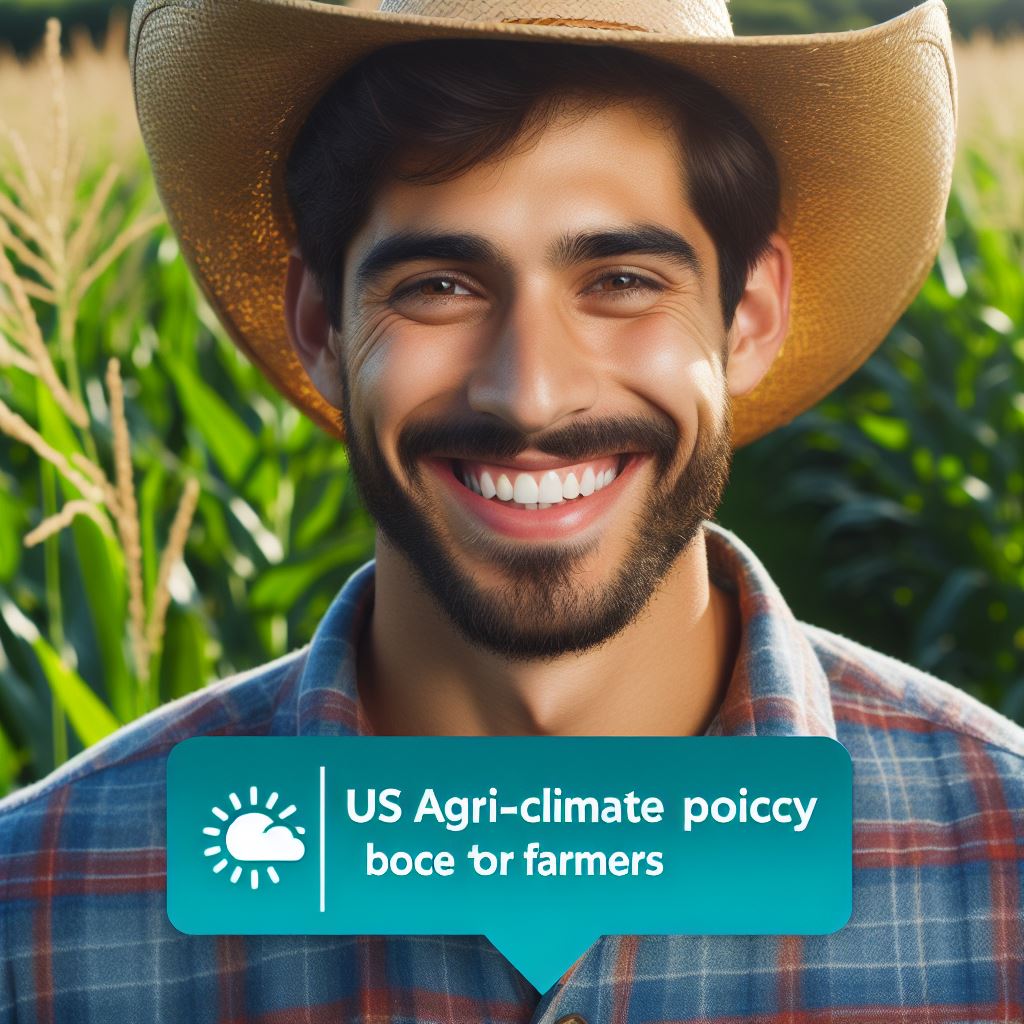Introduction
Climate shifts have a significant impact on farm practices in the US.
Farmers must adapt their practices to new climate conditions to ensure food production.
This blog post will focus on the importance of adapting farm practices in the face of climate shifts in the US.
Climate shifts, caused by factors such as global warming, have resulted in unpredictable weather patterns.
This unpredictability poses challenges to farmers as it affects their ability to plan and execute farming operations effectively.
Changes in temperature, precipitation, and extreme weather events directly impact crop growth, yield, and overall farm productivity.
Adapting farm practices becomes crucial to mitigate the negative impacts of climate shifts.
By implementing innovative techniques and technologies, farmers can adjust their farming methods to optimize production and reduce environmental risks.
For example, they can adopt precision agriculture methods that utilize sensors and data analytics to optimize irrigation and nutrient management, thus conserving resources and reducing pollution.
Moreover, diversifying crops and employing crop rotation can help farmers cope with changing climate conditions.
By cultivating a range of crops and rotating them seasonally, farmers minimize the risk of crop failure due to specific climate conditions.
This practice also enhances soil health, water conservation, and biodiversity.
Additionally, farmers must invest in climate-resilient infrastructure and insurance schemes to safeguard their farms against extreme weather events and related damages.
Such initiatives can provide financial support and aid in the recovery process.
In fact, climate shifts have a profound impact on farm practices in the US.
Adapting to new climate conditions is vital for farmers to ensure a stable food supply, mitigate environmental risks, and protect their livelihoods.
Implementing innovative techniques and technologies, diversifying crops, and investing in resilient infrastructure are essential steps towards adapting farm practices to climate shifts.
Current climate challenges faced by US farmers
In recent years, US farmers have been facing numerous climate challenges that are impacting their ability to maintain profitable operations.
These challenges vary across different regions of the country and include issues such as droughts, floods, and extreme temperatures.
The consequences of these climate challenges are far-reaching, affecting crop yields, livestock production, and overall profitability.
The specific climate challenges faced by farmers in different regions of the US (e.g., droughts, floods, extreme temperatures)
One of the most prevalent climate challenges faced by farmers is drought. In regions such as the Southwest and Great Plains, water scarcity has become a major concern.
Droughts reduce soil moisture levels, leading to decreased plant growth and productivity.
Additionally, the lack of water availability negatively affects livestock by limiting grazing options and causing a decline in forage quality.
Floods, on the other hand, pose a significant challenge for farmers in the Midwest and along coastal regions.
Heavy rainfall can result in excessive soil saturation, leading to flooding and waterlogging.
This waterlogging hampers root growth, suffocates plants, and can eventually cause crop failure.
Moreover, flooding damages infrastructure and can result in financial losses for farmers.
Extreme temperatures, both hot and cold, also pose a threat to agricultural productivity.
Heatwaves can scorch crops and lead to increased evaporation rates, drying out the soil and reducing water availability.
Cold snaps, especially in areas with mild winters, can damage plants and hinder their ability to produce viable crops.
These temperature extremes disrupt the natural growth cycles of plants and negatively impact overall yields.
The impact of these challenges on crop yields, livestock production, and overall profitability
The impact of these climate challenges on crop yields cannot be understated.
According to the USDA, droughts alone have caused an estimated $3 billion in crop losses annually between 2011 and 2017.
Additionally, extreme temperatures have reduced corn yields by 7.5% and soybean yields by 8.3% in recent years.
These statistics highlight the profound economic impact of climate challenges on farmers and the agricultural sector as a whole.
In terms of livestock production, climate challenges also play a significant role.
Droughts, for instance, contribute to a decreased availability of forage for grazing animals.
This forces farmers to either reduce livestock numbers or resort to expensive supplemental feed options, impacting profitability.
Flooding, on the other hand, destroys pastures and infrastructure, leading to financial losses and reduced livestock carrying capacities.
Relevant statistics and examples to support the discussion
Overall profitability is greatly affected by these climate challenges.
Rising production costs, lower crop yields, and increased input requirements all place financial strain on farmers.
The USDA reported that farm incomes in the US have declined by 52% over the past seven years.
These declines are primarily attributed to climate challenges, leaving farmers struggling to adapt and maintain profitable operations.
To mitigate these challenges, farmers are turning to innovative adaptation practices.
Many are implementing sustainable irrigation techniques, such as drip irrigation and precision agriculture, to optimize water usage in drought-prone areas.
Additionally, genetic improvements in crops and the use of resilient crop varieties help combat the adverse effects of extreme temperatures.
Cover cropping and diversification are also popular strategies to improve soil health and reduce vulnerability to climate variability.
In general, US farmers face a range of climate challenges across different regions of the country.
These challenges, including droughts, floods, and extreme temperatures, significantly impact crop yields, livestock production, and overall profitability.
It is essential for farmers to adapt and implement innovative practices to mitigate the consequences of climate shifts and ensure the sustainability of their operations.
By doing so, they can withstand the challenges presented by a changing climate and continue to provide the country with a secure and abundant food supply.
Transform Your Agribusiness
Unlock your farm's potential with expert advice tailored to your needs. Get actionable steps that drive real results.
Get StartedRead: Permaculture: Climate Change Shield
The Need for Adaptive Measures
Adapting farm practices is crucial for long-term sustainability and success in the face of climate shifts.
Farmers must adjust their methods to mitigate the negative impacts of changing weather patterns and ensure their operations remain viable.
Benefits of Adopting Adaptive Measures
By embracing adaptive practices, farmers can reap a host of benefits that contribute to both their own well-being and the environment.
- Increased Resilience: Through adaptive measures, farmers become more resilient to the unpredictable nature of climate change. They can better withstand extreme weather events, such as droughts or floods.
- Enhanced Productivity: Adaptive practices enable farmers to optimize their productivity even in the face of changing conditions. They can adopt new technologies and techniques that improve efficiency and maximize yields.
- Reduced Environmental Impact: Adapting farm practices goes hand in hand with environmental stewardship. By implementing sustainable methods, farmers can minimize their carbon footprint, conserve resources, and protect biodiversity.
Examples of Successful Adaptive Practices
Farmers across different parts of the US have already embraced adaptive measures, showcasing the potential for sustainable agricultural practices that benefit both farmers and the environment.
- Rotational Grazing: In the Midwest, farmers have implemented rotational grazing systems, where livestock are regularly moved between different pastures. This reduces overgrazing, maintains soil health, and enhances carbon sequestration.
- Cover Cropping: In the Pacific Northwest, farmers have adopted cover cropping, whereby specific plants are grown between main crops. These cover crops protect the soil from erosion, improve organic matter, and suppress weeds naturally.
- Water Conservation: In arid regions like the Southwest, farmers have implemented innovative water conservation techniques, such as drip irrigation or precision agriculture. These practices optimize water usage and minimize wastage, ensuring sustainable water management.
- Agroforestry: In the Northeast, farmers have integrated tree crops with traditional agricultural practices. Agroforestry systems provide multiple benefits, such as improved soil health, shade for livestock, and diversified income streams.
- Climate-Resilient Crop Selection: Farmers in the Southeast have been selecting crop varieties that are better adapted to changing climatic conditions. This approach helps mitigate the risks associated with extreme temperatures or shifting precipitation patterns.
In short, adapting farm practices is crucial for long-term sustainability and success in the face of climate shifts.
The benefits of adopting adaptive measures, such as increased resilience, enhanced productivity, and reduced environmental impact, cannot be overstated.
Farmers across the US have already implemented successful adaptive practices, showcasing the potential for a sustainable future in agriculture.
By embracing these practices, farmers can not only thrive in an ever-changing climate but also contribute to a more resilient and environmentally friendly food system.
Read: Farming in Flood Zones: Best Practices

Key strategies and practices for adapting to climate shifts
- Crop diversification: By diversifying crops, farmers can reduce the impact of climate shifts on their overall yield. Different crops have varying levels of tolerance to temperature, precipitation, and other climate variables. If one crop fails due to unfavorable conditions, others may still thrive, providing a buffer against climate-related losses.
- Water conservation: With climate shifts, changes in precipitation patterns can result in droughts or excessive rainfall. Implementing water conservation techniques allows farmers to maintain adequate soil moisture levels during dry periods and prevent waterlogging during heavy rain. The use of precision irrigation methods, such as drip irrigation, helps deliver water directly to the plant roots, minimizing evaporation and water waste.
- Precision agriculture: Precision agriculture involves the use of technology, such as sensors, GPS, and drones, to collect data on soil moisture, nutrient levels, and crop health. By analyzing this data, farmers can make precise decisions regarding planting, fertilization, and pest control. This optimization leads to efficient resource utilization, greater crop yields, and reduced environmental impact.
Share success stories of farmers who have implemented these adaptive measures with positive outcomes
Now, let’s explore some success stories of farmers who have implemented these adaptive measures:
- Mark Johnson, a corn farmer: Mark diversified his crops by introducing soybeans into his rotation. When a severe drought hit his region, the soybeans were able to tolerate the dry conditions better than corn, allowing him to mitigate the impact of the climate shift on his overall yield.
- Lisa Patel, an apple orchard owner: Lisa implemented precision agriculture techniques, including soil sensors and weather stations. By monitoring soil moisture levels and weather patterns, she optimized irrigation schedules, resulting in better water usage efficiency and improved apple production.
- Carlos Martinez, a vegetable farmer: Carlos adopted water conservation practices such as implementing efficient sprinkler systems and mulching. As a result, he was able to reduce water usage by 30% while still maintaining high-quality produce. This not only saved him money but also contributed to sustainable water management in his region during a period of water scarcity.
These success stories demonstrate how the adoption of various strategies and practices can help farmers adapt to climate shifts and improve their productivity.
By learning from proactive farmers like Mark, Lisa, and Carlos, others in the agricultural community can also implement these measures to safeguard their livelihoods in an increasingly unpredictable climate.
Read: Protecting Crops from Extreme Rainfall
Challenges and barriers to implementing adaptive measures
Acknowledge the potential challenges and barriers that farmers may face when trying to adapt their practices
Climate change poses significant challenges for farmers in the United States as they strive to adapt their practices to the shifting climate.
In order to successfully implement adaptive measures, farmers must first acknowledge and overcome potential barriers and challenges.
This blog section will explore the various difficulties that farmers may face and discuss possible solutions and resources to address them.
One of the key challenges farmers encounter when attempting to adapt their practices is the financial burden associated with implementing new technologies and approaches.
Upgrading machinery and infrastructure, investing in climate-resilient crop varieties, and implementing new irrigation methods can all be costly endeavors.
Limited access to capital and credit can further exacerbate this financial barrier.
Possible financial, technological, and regulatory hurdles that need to be overcome
Fortunately, there are several resources available to address these financial challenges.
Government support programs, such as grants and loans, can provide financial assistance to farmers looking to implement adaptive measures.
These programs can help offset the initial costs and make climate adaptation more accessible to farmers.
Additionally, collaboration and partnerships between farmers, researchers, and industry stakeholders can facilitate the development of innovative financing models tailored specifically to the agricultural sector.
Technological barriers also pose significant challenges to the adoption of adaptive practices.
Farmers may lack access to the necessary tools and information needed to effectively monitor and respond to changing climate conditions.
This includes weather forecasting technologies, precision agriculture tools, and data collection and analysis systems.
Limited technological literacy among farmers can further hinder the adoption of these tools.
Suggestions and resources for addressing these challenges
To address these technological hurdles, it is crucial to invest in research and development initiatives focused on developing user-friendly technologies that cater to the needs and capacities of farmers.
Government funding can support research partnerships between universities, agricultural extension services, and technology developers.
This collaboration can lead to the creation of innovative and affordable technologies specifically designed for the agricultural sector.
Regulatory barriers also impede farmers’ ability to adapt their practices.
Existing policies and regulations may not adequately address the challenges posed by climate change or may inadvertently hinder climate adaptation efforts.
This can include outdated regulations regarding land use, water rights, and crop insurance.
To overcome regulatory hurdles, farmers can actively engage in policy advocacy and promote the development of climate-smart policies.
This involves collaborating with agricultural associations, environmental organizations, and policymakers to push for reforms that incentivize and support climate adaptation.
Additionally, governments can play a crucial role in providing clear guidelines and regulations that promote sustainable farming practices and incentivize climate resilience.
In a nutshell, implementing adaptive measures in agriculture requires addressing several challenges and barriers.
Financial limitations, technological gaps, and regulatory hurdles all contribute to the difficulties farmers face.
However, with the support of government programs, research initiatives, and collaboration among stakeholders, these challenges can be overcome.
By acknowledging these barriers and actively seeking solutions, farmers can successfully adapt their practices to the changing climate and ensure the long-term resilience of the agriculture sector.
Read: Eco-Pest Control in Modern Farming
Conclusion
Adapting farm practices to climate shifts is not just a necessity but a fundamental imperative for the agricultural sector in the United States.
The ever-evolving nature of climate patterns poses significant challenges to farmers, ranging from unpredictable weather events to shifting growing seasons and altered pest and disease patterns.
However, amidst these challenges, US farmers have demonstrated remarkable resilience and innovation.
They have continuously adapted their techniques and practices to mitigate the impacts of climate change on their crops and livestock.
From implementing precision agriculture and adopting drought-resistant crop varieties to integrating sustainable farming methods and enhancing soil health, farmers across the country have embraced innovative approaches to safeguard their livelihoods and ensure food security for the nation.
Nevertheless, the journey towards climate-resilient agriculture does not end here.
It requires a concerted effort from various stakeholders, including policymakers, researchers, agricultural extension services, and the farming community itself.
Continued research into climate-smart farming techniques, improved access to financial support and resources, and fostering collaboration among different sectors are essential for advancing the adaptation of farm practices.
Moreover, addressing climate change in agriculture is not just about mitigating risks; it’s about seizing opportunities for a sustainable and productive future.
By embracing adaptive strategies and harnessing the power of innovation, US farmers can not only withstand the challenges posed by climate shifts but also thrive in a changing environment.
In essence, the importance of adapting farm practices to climate shifts cannot be overstated.
It is a collective responsibility that demands unwavering commitment and collaboration to ensure a resilient, sustainable, and prosperous agricultural sector for generations to come.




